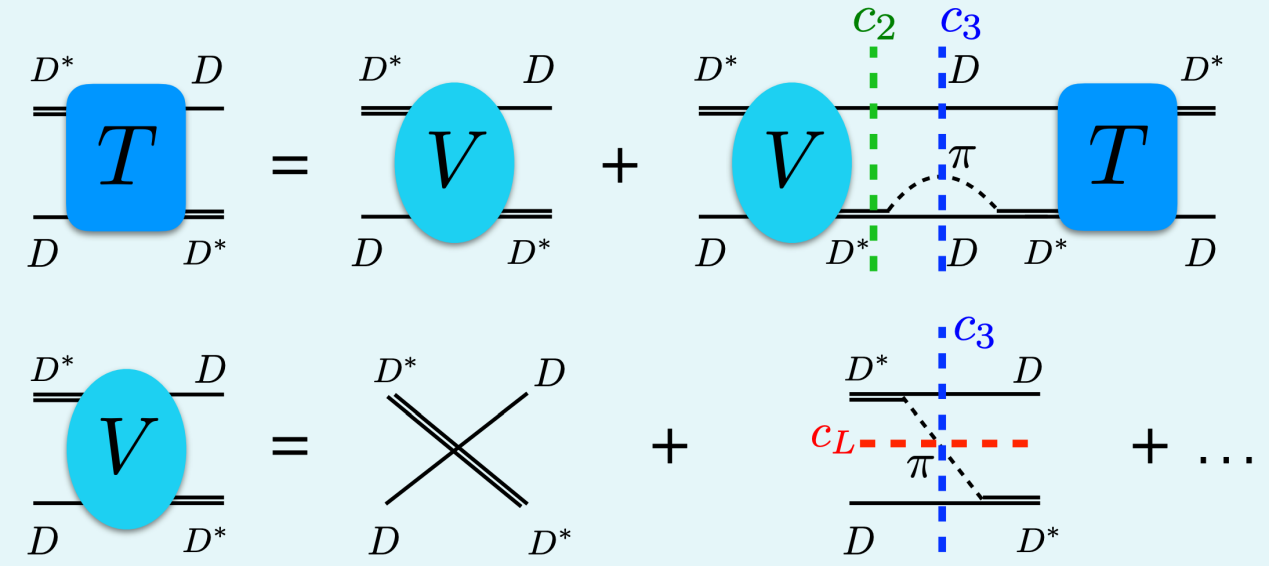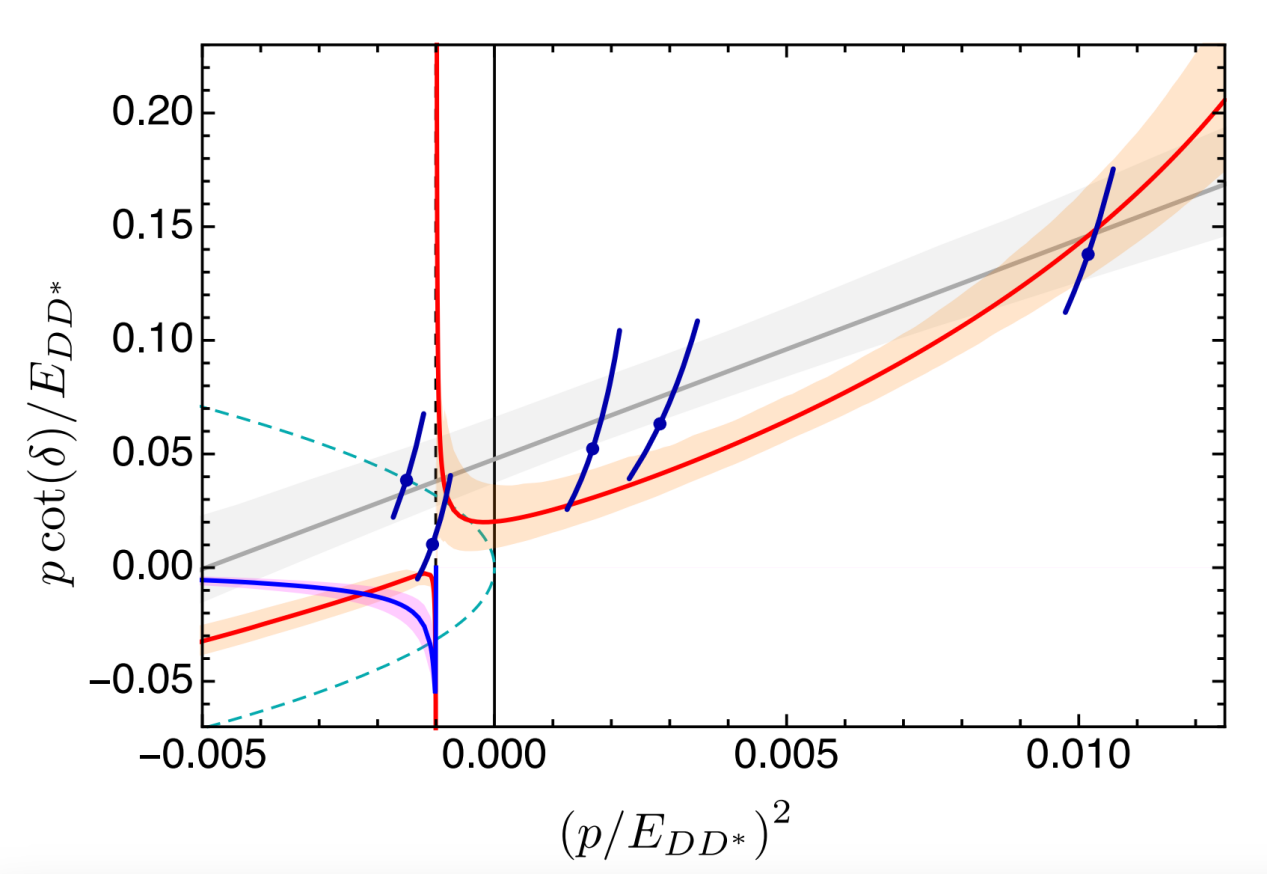Research Progress
Role of left-hand cut contributions on pole extractions
Hadrons are colorless particles made up of colorful quarks and gluons. In the traditional quark model, hadrons include baryons consisting of three quarks and mesons consisting of a pair of quark and antiquark, and hadrons beyond these configurations are known as exotic states. In the last two decades, many candidates for exotic states have been discovered. Studying the structures and properties of these exotic states is currently one of the foci of hadron physics. For multiquark states (e.g., tetraquark states consisting of two pairs of quark and antiquark or pentaquark states composed of four quarks and one antiquark), there are different possibilities for the distribution of quarks inside them. One possibility is that different quarks (or antiquarks) first bind to form colorless groups and then form a molecule-like cluster structure through the residual interactions of the strong interactions; in this case, color confinement occurs within the colorless subgroup. Another possibility is that there is no smaller colorless cluster inside the multiquark state, and thus, color confinement plays an important role among all quarks. It follows that studying the internal structure of the multiquark states is important for understanding the fundamental problem of color confinement. The low-energy scattering between two hadrons contains essential information about the internal structure of the multiquark states coupled to them. It is the subject of many theoretical and lattice QCD calculations.
Hadron states correspond to the poles of the scattering amplitude. By constructing the scattering amplitudes, calculating the corresponding physical quantities, and fitting the experimental or lattice QCD data, we can obtain the mass, width, and other parameters of hadronic states. Although the experimentally measurable energies are real numbers, we can use analytic continuation to extend the energies to complex numbers, and the analytic nature of the scattering amplitude as a function of the energy is related to basic physical requirements such as causality and conservation of probability. Scattering amplitudes contain two main types of singularities: poles and cuts. The real and imaginary parts of a pole usually correspond to the mass and half-width of the particle. At the same time, cuts are caused by the fact that intermediate particles can be on their mass shell during the interaction process. Extracting the masses and widths of particles is one of the main tasks in the study of hadron spectra from experimental data and lattice QCD calculations.
In 2021, the discovery of a doubly-charmed tetraquark state by the LHCb experiment at the CERN LHC has stimulated a great deal of excitement. Three different lattice QCD groups have computed this system separately. In Ref.[1], researchers fitted the scattering phase shift calculated by lattice QCD using an effective range expansion and found that there exists a virtual pole below the threshold on the unphysical Riemann sheet, which is supposed to correspond to the double-charm tetraquark discovered at the LHCb experiment.
Recently, Prof. Meng-Lin Du from the University of Electronic Science and Technology, Ph.D. student Xiang-Kun Dong and Prof. Feng-Kun Guo from the Institute of Theoretical Physics, Chinese Academy of Sciences, Prof. Qian Wang from the South China Normal University, along with their collaborators from Germany, Russia and Spain, studied this system. They found that since the lightest hadron, the pion, which plays an essential role in the nuclear force, can be exchanged in the interaction, the resulting left-hand cut (in Fig. 1) is very close to the threshold, which significantly restricts the radius of convergence of the effective range expansion used in Ref.[1], and consequently, affects the reliability of the pole positions obtained therein. They found that the phase shift obtained after considering pion exchange in the interaction via chiral effective field theory (red solid line in Fig. 2) is significantly different from those obtained by the effective range expansion (gray solid line in Fig. 2). There is also a zero near the branch point of the left-hand cut (the location where the red line in the figure diverges), which greatly limits the radius of convergence of the effective range expansion. This directly affects the extraction of the pole positions. Such effect of the left-handed cut is widespread in many hadronic composite systems and needs to be carefully handled when extracting the pole positions.


This work has been published in Phys. Rev. Lett. This work is supported in part by the National Natural Science Foundation of China (NSFC) and the Deutsche Forschungsgemeinschaft (DFG) through the funds provided to the Sino-German Collaborative Research Center TRR110, by the Chinese Academy of Sciences, by Guangdong Provincial Funding, and so on.
[1] M. Padmanath, S. Prelovsek, Phys.Rev.Lett. 129 (2022) 032002.
[2] M.-L. Du, A. Filin, V. Baru, X.-K. Dong, E. Epelbaum, F.-K. Guo, C. Hanhart, A. Nefediev, J. Nieves, and Q. Wang, Phys. Rev. Lett. 131, 131903 (2023).
